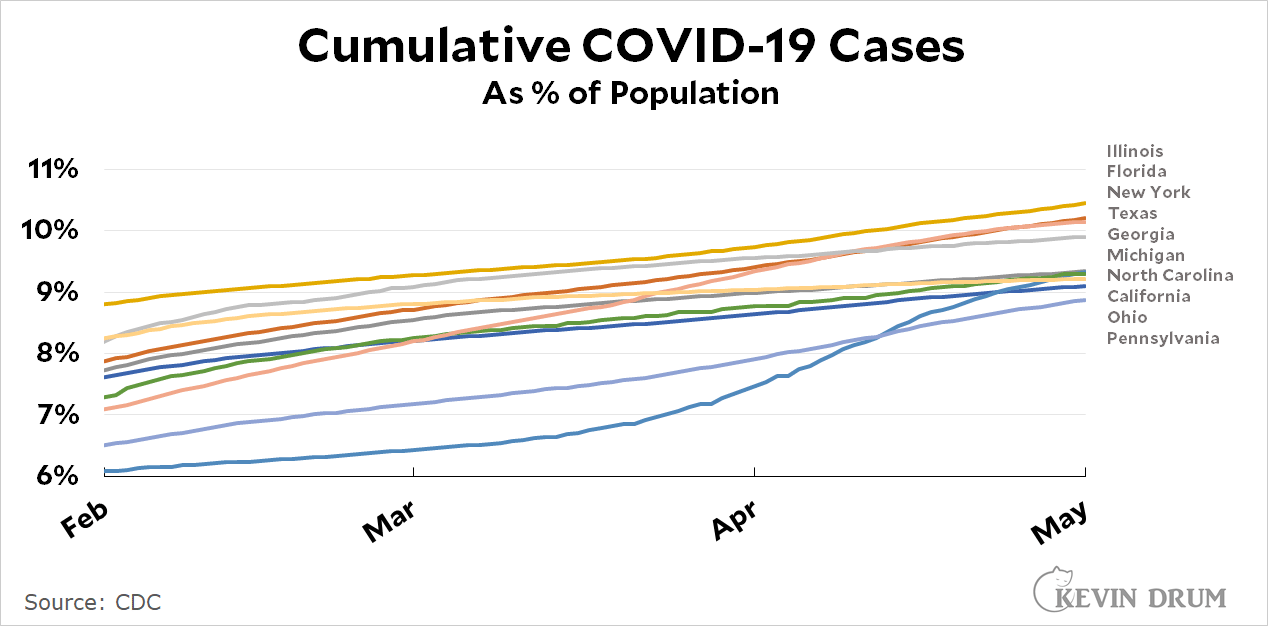So how is everybody doing on the COVID-19 front? Here are cumulative COVID-19 cases for the ten largest states. I'm showing just the past few months so that the differences are visible to the human eye:

Total cases to date range from 8.9% (Pennsylvania) to 10.4% (New York). California is flattening out at the moment, while every other state is continuing to rise.
I'm really unsure what lesson to take here. On the one hand, sure, some states are doing better than others. On the other hand, the differences aren't huge. To some extent I think that's because different state regulations have (a) been less different than you'd think, and (b) are playing second fiddle to local and corporate rules anyway. Texas can declare that no one needs to wear masks, but if restaurants and supermarkets continue to require them then people will wear masks.
UPDATE: I made a mistake in the original version of the chart, omitting Pennsylvania and adding New Jersey. Both the chart and the text have been corrected.

At least one of the differences is huge. One state has seen cumulative cases increase by 50%, while other states have seen 10% increases. Indexing states to the same starting point would make this easier to see.
More importantly, at this point in the endgame, we shouldn't still be seeing these kinds of increases. The messaging from January on should have been consistent: you've worked hard to get this far, hang tight for just a little bit longer, it looks like May is when we will start reopening (assuming 70% of adults get vaccinated).
That message has different meaning for different states. Here in FL things have been back to normal for many months other than the wearing of masks. I can't think of anything in day to day life that is really different now as opposed to pre-pandemic. (Cruises not taking place the one exception off the top of my head.)
Well, Mr. Drum, you have been living in California through this. Surely you remember that after the first couple of months, enforcement of the regulations for business shutdowns, social distancing, and masking largely evaporated. So the situation was not much different from what prevailed in states that had lax regulations, or none at all. The adoption of non-pharmacological interventions was driven by those localities that actually enforced regulations (including businesses) and what people undertook to do on their own in response to their impressions of the current state of the epidemic.
Look, I live in north Orange County. When I go out for my regular walks, I see that the percentage of people wearing masks now, with relaxed regulations and low incidence rates, is not noticeably different from what it was during the worst days of January and February, when things were raging and we were still in the regulatory "orange tier." It was close to zero then and remains so now.
Lockdowns, as practiced in the US and Europe, that is, imposed only after community spread is already out of control, withdrawn before the situation is resolved, and patchily enforced while in effect, really don't make much difference, if any at all. I guess that's not very surprising.
At one point California was near the top in case rate (cases per capita), back when L.A. was going through (a somewhat reduced) version of the NYC Covid Crisis and some of California's interior counties were unmasked and out of control. But no more; of the 50 states it's dead last and has been for some time. With a test positivity rate of less than 1% this is no illusion, either.
"Texas can declare that no one needs to wear masks, but if restaurants and supermarkets continue to require them then people will wear masks."
As a (reluctant Texan), I can tell you that corporate policies re masks in restaurants and supermarkets were poorly followed when Texas (grudgingly) said masks were needed, and it's gotten worse ever since Texan leadership declared masks were no longer needed.
I think that your hypothesis that local and corporate rules are playing a role that swamps state policies misses a bigger point: group identity and politics are national, and one national party decided to turn mask-wearing into a wedge issue.
Here is a map of average daily new covide cases per 100,000 people, as of 1 May,
https://old.reddit.com/r/MapPorn/comments/n43h06/average_new_covid19_cases_per_100000_people_in/
What is the issue with Michigan and Alberta? Can that really be chalked up to crank wingnuttism?
RE: Michigan
Sort of. The increase in cases correlates very closely with opening up school sports which was pushed heavily by the wingnuts abetted by the clueless. It also appears to be exacerbated by a variant that is more contagious and more likely to affect the kids.
Also, the Governor has less authority to impose lockdowns since the legislature sued and the State Supreme Court threw out the emergency powers law that she was using as justification.
Why would school sports in MI be such a factor but not other states? FL has had school sports all year and there hasn't been any issues.
Youth sports and other extracurriculars are spreading Covid-19, health officials say,
https://edition.cnn.com/2021/04/06/health/youth-sports-covid-spread-wellness/index.html
Here is a map of American willingness to get the vaccine,
https://old.reddit.com/r/MapPorn/comments/n3xa3g/a_map_of_americans_willingness_to_get_the_covid19/
What I find striking about this is that if you remove the border lines you can still make out the outlines of most of the states.
This is how we divide and die.
COVID-19 | A.P. strain at least 15 times more virulent,
https://www.thehindu.com/news/national/andhra-pradesh/ap-strain-at-least-15-times-more-virulent/article34474035.ece
Why is NJ in this list of “ten biggest states”? Why is PA not in the list?